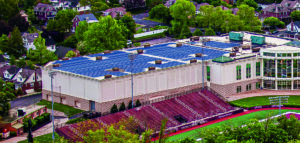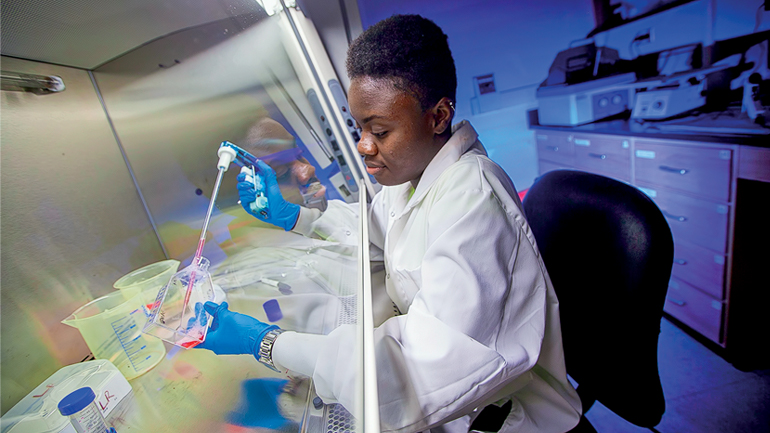Campus News: What’s Ahead in 2021
On-Campus Solar
As part of the College’s goal to reach carbon neutrality by 2035, solar panels will be installed on the sun-soaked roof of Kirby Sports Center in summer or fall 2021. Energy collected by the 400- to 530-kilowatt solar array will be used to power systems in Kirby. “This project is intended to help visually demonstrate to the Lafayette community and visitors the commitment that Lafayette has to achieving carbon neutrality and using the campus as a living laboratory,” says Delicia Nahman, director of sustainability.

Solar panels coming to Kirby Sports Center.
With an ever-expanding interest in renewable energy, faculty have an interest in integrating the project into courses for hands-on learning opportunities. Emily Ross ’22 (chemical engineering, minor in environ-mental science), working as an intern on the project, will attend biweekly meetings to absorb information and learn, and be involved in it through the spring semester and possibly the summer. “I’m hoping to pursue a career in renewable energy after graduation, so getting a close-up look at this process is an exciting and informative opportunity,” Ross says. “I’m looking forward to learning more throughout the semester as we apply for permits and begin construction.”
Learn more about sustainability initiatives at sustainability.lafayette.edu
Global Cities Initiative
 The Global Education and Research Advisory Council is launching a two-year initiative to focus classroom and scholarly investigations on global cities. The idea is to create, connect, and publicize teaching and scholarship under the sub-themes of pandemic, power, production, and peripheries. The series opened in the spring 2021 semester, focusing on the issue of pandemics, and global cities. Co-chaired by Angelika von Wahl, professor of international affairs, Michelle Geoffrion-Vinci, professor of foreign languages and literatures, and Ingrid Furniss, associate professor of art, this multidisciplinary initiative will feature panels, presentations, speakers, films, performances, exhibits, and other similar events that focus, in diverse ways, on the overarching theme of global cities and related topics.
The Global Education and Research Advisory Council is launching a two-year initiative to focus classroom and scholarly investigations on global cities. The idea is to create, connect, and publicize teaching and scholarship under the sub-themes of pandemic, power, production, and peripheries. The series opened in the spring 2021 semester, focusing on the issue of pandemics, and global cities. Co-chaired by Angelika von Wahl, professor of international affairs, Michelle Geoffrion-Vinci, professor of foreign languages and literatures, and Ingrid Furniss, associate professor of art, this multidisciplinary initiative will feature panels, presentations, speakers, films, performances, exhibits, and other similar events that focus, in diverse ways, on the overarching theme of global cities and related topics.
Read more at bit.ly/30uEc5h
Innovative Dyer Center Programming
The Dyer Center for Innovation and Entrepreneurship has launched a four-year program to develop the next generation of innovators. Designing Your Entrepreneurial Roadmap (D.Y.E.R.) is a paid sequenced and progressive four-year program that begins with the foundational mechanics of innovation and entrepreneurship and culminates with a $4,000 investment in a student’s development. Backed by the College’s extensive resources in classroom education, broad-range liberal arts thinking, committed alumni network, and robust experiential learning, D.Y.E.R. launches students toward a life of creativity, innovation, and intelligent risk-taking. Program stages over four years involve skill building, personal development, entrepreneurial thinking, hands-on ventures such as mentorships, startups, and contests, and network building.
Learn more about the Dyer Center at dyer.lafayette.edu
More Research Opportunities for Women
The Henry Luce Foundation awarded a $243,276 grant to Lafayette College through its Clare Boothe Luce Program for Women in STEM. This three-year grant will support 48 female undergraduate research scholars majoring in engineering through faculty-mentored research, along with related programs and activities. Of the 48 scholars, 24 will be supported by the College.

Aaliyah Shodeinde ’17 works on cell culture preparation in an engineering lab.
This prestigious and timely award comes as Lafayette celebrates the 50th anniversary of women at the College. It will support Lafayette’s continued efforts to provide opportunities for women while partnering with a national leader to shape women’s roles in STEM fields. The grant also will advance an inclusive culture for the education of women engineers, with an emphasis on supporting the success of women of color.
Read more at bit.ly/2LWgg7b
Celebrating 50 years of Engineering Studies
For 50 years, the engineering studies program has put students on a path to adventurous careers from environmental fields and consulting to construction management and digital industries, approaching challenges with a grounding in engineering and the liberal arts.
Created with the goal of producing graduates who could bridge the gap between engineering and the liberal arts, the program’s current mission is to engage students in engineering as a liberal art, recognizing the increasingly complex challenges of sociotechnical systems and examining these systems through multidisciplinary perspectives. The program helps students gain expertise in examining the place of engineering and technology in society, with interdisciplinary skills to lead public technology debates around issues related to policy, management, economics, and the environment.
As a result, students who graduate with a degree in engineering studies are hardwired into Lafayette’s rich liberal arts and scientific traditions, and well prepared to accept interdisciplinary challenges related to how science and technology affect society.
“There are so many alumni doing so many amazing things,” says Benjamin Cohen, chair of engineering studies and associate professor. “We’ve been extraordinarily successful. Students go into various professions; they head to med school, law school, and business school; they go into education. “We have good job placement, with starting salaries in the top 10 for Lafayette grads,” he says. “With only two tenure track faculty, we do a lot with a little, graduating 18 to 20 students a year. So our graduates per faculty are near the top at the College.”
The program also has evolved to be a leader in advancing diversity in engineering, Cohen says. “Because we have built strong relationships across campus and with the new Hanson Center for Inclusive STEM studies, we are poised to help the College graduate students who can, for example, lead their industries in issues of racial and environmental justice,” he says.